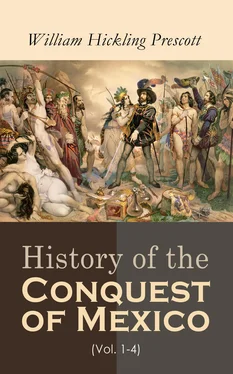Ixtlilxochitl’s writings have many of the defects belonging to his age. He often crowds the page with incidents of a trivial, and sometimes improbable, character. The improbability increases with the distance of the period; for distance, which diminishes objects to the natural eye, exaggerates them to the mental. His chronology, as I have more than once noticed, is inextricably entangled. He has often lent a too willing ear to traditions and reports which would startle the more skeptical criticism of the present time. Yet there is an appearance of good faith and simplicity in his writings, which may convince the reader that when he errs it is from no worse cause than national partiality. And surely such partiality is excusable in the descendant of a proud line, shorn of its ancient splendors, which it was soothing to his own feelings to revive again—though with something more than their legitimate lustre—on the canvas of history. It should also be considered that, if his narrative is sometimes startling, his researches penetrate into the mysterious depths of antiquity, where light and darkness meet and melt into each other, and where everything is still further liable to distortion, as seen through the misty medium of hieroglyphics. [349]
With these allowances, it will be found that the Tezcucan historian has just claims to our admiration for the compass of his inquiries and the sagacity with which they have been conducted. He has introduced us to the knowledge of the most polished people of Anahuac, whose records, if preserved, could not, at a much later period, have been comprehended; and he has thus afforded a standard of comparison which much raises our ideas of American civilization. His language is simple, and, occasionally, eloquent and touching. His descriptions are highly picturesque. He abounds in familiar anecdote; and the natural graces of his manner, in detailing the more striking events of history and the personal adventures of his heroes, entitle him to the name of the Livy of Anahuac.
I shall be obliged to enter hereafter into his literary merits, in connection with the narrative of the Conquest; for which he is a prominent authority. His earlier annals—though no one of his manuscripts has been printed—have been diligently studied by the Spanish writers in Mexico, and liberally transferred to their pages; and his reputation, like Sahagun’s, has doubtless suffered by the process. His Historia Chichimeca is now turned into French by M. Ternaux-Compans, forming part of that inestimable series of translations from unpublished documents which have so much enlarged our acquaintance with the early American history. I have had ample opportunity of proving the merits of his version of Ixtlilxochitl, and am happy to bear my testimony to the fidelity and elegance with which it is executed.
Note.—In a note which has heretofore appeared at the end of this first book Mr. Prescott states that it had been his intention to conclude the introductory portion of the work with an inquiry into the origin of the Mexican civilization. But because he agreed with Humboldt, that “the general question of the origin of the inhabitants of a continent is beyond the limits prescribed to history,” and with Livy, that “for the majority of readers the origin and remote antiquities of a nation can have comparatively little interest,” he had decided, on further consideration, to throw his observations on this topic into the Appendix. A man of extraordinary modesty, he feared lest the reader should become so wearied with his presentation of the story of the earlier civilization, in the first book, that he would not have energy enough left for the proper consideration of the tale of the Conquest, set forth with such conscientious care in the succeeding chapters. The essay has now been taken from the Appendix and placed in its proper position.—M.
THE ORIGIN OF THE MEXICAN CIVILIZATION
PRELIMINARY NOTICE
Table of Contents
THE following Essay was originally designed to close the Introductory Book, to which it properly belongs. It was written three years since, at the same time with that part of the work. I know of no work of importance, having reference to the general subject of discussion, which has appeared since that period, except Mr. Bradford’s valuable treatise on American Antiquities . But in respect to that part of the discussion which treats of American Architecture a most important contribution has been made by Mr. Stephens’s two works, containing the account of his visits to Central America and Yucatan, and especially by the last of these publications. Indeed, the ground, before so imperfectly known, has now been so diligently explored that we have all the light which we can reasonably expect to aid us in making up our opinion in regard to the mysterious monuments of Yucatan. It only remains that the exquisite illustrations of Mr. Catherwood should be published on a larger scale, like the great works on the subject in France and England, in order to exhibit to the eye a more adequate representation of these magnificent ruins than can be given in the limited compass of an octavo page.
But, notwithstanding the importance of Mr. Stephens’s researches, I have not availed myself of them to make any additions to the original draft of this Essay, nor have I rested my conclusions in any instance on his authority. These conclusions had been formed from a careful study of the narratives of Dupaix and Waldeck, together with that of their splendid illustrations of the remains of Palenque and Uxmal, two of the principal places explored by Mr. Stephens; and the additional facts collected by him from the vast field which he has surveyed, so far from shaking my previous deductions, have only served to confirm them. The only object of my own speculations on these remains was to ascertain their probable origin, or rather to see what light, if any, they could throw on the origin of Aztec Civilization. The reader, on comparing my reflections with those of Mr. Stephens in the closing chapters of his two works, will see that I have arrived at inferences, as to the origin and probable antiquity of these structures, precisely the same as his. Conclusions formed under such different circumstances serve to corroborate each other; and, although the reader will find here some things which would have been different had I been guided by the light now thrown on the path, yet I prefer not to disturb the foundations on which the argument stands, nor to impair its value—if it has any—as a distinct and independent testimony.
ORIGIN OF THE MEXICAN CIVILIZATION—ANALOGIES WITH THE OLD WORLD
Table of Contents
When the Europeans first touched the shores of America, it was as if they had alighted on another planet,—every thing there was so different from what they had before seen. They were introduced to new varieties of plants, and to unknown races of animals; while man, the lord of all, was equally strange, in complexion, language, and institutions. [350]It was what they emphatically styled it,—a New World. Taught by their faith to derive all created beings from one source, they felt a natural perplexity as to the manner in which these distant and insulated regions could have obtained their inhabitants. The same curiosity was felt by their countrymen at home, and the European scholars bewildered their brains with speculations on the best way of solving this interesting problem.
In accounting for the presence of animals there, some imagined that the two hemispheres might once have been joined in the extreme north, so as to have afforded an easy communication. [351]Others, embarrassed by the difficulty of transporting inhabitants of the tropics across the Arctic regions, revived the old story of Plato’s Atlantis, that huge island, now submerged, which might have stretched from the shores of Africa to the eastern borders of the new continent; [352]while they saw vestiges of a similar convulsion of nature in the green islands sprinkled over the Pacific, once the mountain summits of a vast continent, now buried beneath the waters. [353]Some, distrusting the existence of revolutions of which no record was preserved, supposed that animals might have found their way across the ocean by various means; the birds of stronger wing by flight over the narrowest spaces; while the tamer kinds of quadrupeds might easily have been transported by men in boats, and even the more ferocious, as tigers, bears, and the like, have been brought over, in the same manner, when young, “for amusement and the pleasure of the chase”! [354]Others, again, maintained the equally probable opinion that angels, who had, doubtless, taken charge of them in the ark, had also superintended their distribution afterwards over the different parts of the globe. [355]Such were the extremities to which even thinking minds were reduced, in their eagerness to reconcile the literal interpretation of Scripture with the phenomena of nature! The philosophy of a later day conceives that it is no departure from this sacred authority to follow the suggestions of science, by referring the new tribes of animals to a creation, since the deluge, in those places for which they were clearly intended by constitution and habits. [356]
Читать дальше












